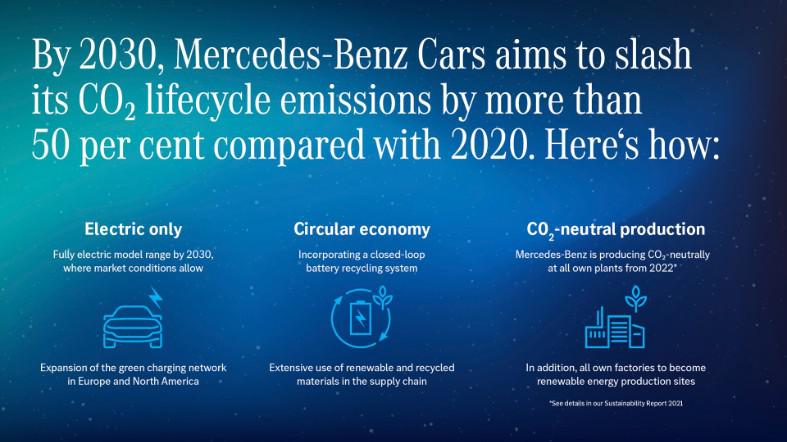At its first digital ESG (Environment, Social and Governance) Conference for investors and analysts, automaker Mercedes-Benz announced enhanced measures aimed at cutting CO2 emissions, which includes a faster transition to electric cars in order to slash CO2 emissions by half by the end of the decade compared to 2020 levels.
To achieve this aggressive goal, Mercedes-Benz says it will continue electrifying its vehicle fleet, build EV charging infrastructure using green energy, improving its electric vehicle battery technology, as well as the extensive use of recycled materials and renewable energy during production.
Some sustainable materials are already being used in series production of some Mercedes-Benz models, including seat upholstery fabrics made from 100% recycled PET bottles as well as floor coverings made with yarns from fishing nets recovered and fabric remnants from old carpets. These materials are also being used by EV startup Fisker Inc for its electric Fisker Ocean SUV. It's where the vehicle derives its name.
Mercedes-Benz aims to increase the use of recycled materials per vehicle to 40% by 2030.
"The desire for individual mobility keeps growing. Our mission is to meet this need in a sustainable way,"says Ola Källenius, Chairman of the Board of Management of Mercedes-Benz Group AG. "Mercedes-Benz has a clear roadmap on how to become carbon-neutral. By 2030, we want to reach the half-way mark. In order to make faster progress in protecting the climate we need maximum dedication and more collaboration among governments, companies and society as a whole."
The automaker also plans to cover more than 70% of its energy needs using renewable energy by 2030. This includes rolling out solar and wind power at own sites as well as through additional solar power purchase agreements with third parties. Using renewable energy for charging is significant in helping Mercedes-Benz cut CO2 emissions.
Mercedes-Benz offers "green charging" at all of roughly 300,000 public charging sites in the "Mercedes me" Charge network throughout Europe. It ensures that a sufficient amount of electricity from renewable sources is fed into the grid, according to the automaker.
As part of the automaker's initiative, Mercedes-Benz aims for up to 50% of its lineup to be plug-in hybrids and fully-electric models by 2025, with the goal to go all-electric by 2030.
New Mercedes models will soon include nine, all-electric models launched under the automaker's dedicated EQ electric-only brand. Mercedes-Benz has already unveiled the EQA, EQB, EQC, EQS, the EQE 350+ and EQV.
Additional EQ models are also in the works, including the flagship EQS electric SUV, the EQE SUV and the EQT.
Mercedes-Benz also plans to electrify its entire lineup of commercial vans.

Mercedes says that battery production presents the biggest opportunity for reducing CO2. Currently in the EU, supply chain and production account for more than half of the lifecycle CO2 emissions. This figure can be reduced through the use of renewable energy.
Mercedes-Benz plans to transition to CO2-neutral battery cell production, which the automakers say can reduce CO2 emissions for the production of the entire battery pack by 20 percent. Additional CO2 reduction is expected to be achieved by improving the anode and cathode production process.
The automaker has formed strategic partnerships to develop and industrialize highly advanced battery cell technologies such as high-silicon anodes, which offer great potential in increasing the energy density of EV batteries. Mercedes-Benz expects to use cobalt-free, lithium iron phosphate (LFP) batteries in future series-production vehicles. The automaker is also working on solid-state batteries.
As part of the automaker's risk-based "Human Rights Respect System", Mercedes-Benz increases transparency and takes appropriate measures in relation to 24 raw materials used for battery production that could increase risk, such as the mining of cobalt.
Mercedes-Benz's corporate ambition is to ensure that human rights are respected along the entire supply chain,from the mines where raw materials are extracted, to the processing companies, and finally to its own battery cell production.
To keep control of the battery lifecycle in-house, Mercedes-Benz is starting a CO2-neutral recycling factory in Kuppenheim, Germany that will recycle end-of-life electric vehicle batteries using a new hydrometallurgical technique which increases the recycling rate of battery raw materials to 96%, the company claims.
"Green Steel and Aluminum"
Another target for CO2 reduction is in the production of steel and aluminum used to manufacture the vehicle's chassis and body. Mercedes-Benz is setting up a green steel supply chain that will significantly increase theuse of low-CO2 and zero CO2 steel. The automaker plans to work closely with its steel suppliers on the avoidance and reduction of CO2 emissions.
In 2021, Mercedes-Benz became the first automaker to take an equity stake in Swedish start-up H2 Green Steel (H2GS), with the goal of using green steel in a number of production models by as early as 2025.
Mercedes-Benz is steadily increasing the proportion of secondary aluminum it uses. The automaker was the first to commit to sourcing aluminum certified by the "Aluminum Stewardship Initiative" (ASI) for its stamping plants and foundries in Europe in the future.
This ensures that the raw materials are obtained and processed responsibly, as well as in an ecological manner. This includes the mining, melting and refining process, regardless of the country its sourced from. Mercedes-Benz said this requirement will be rolled out to other locations outside Europe in the medium term.
To reach its goal of producing electric only vehicles by 2030 and curbing CO2 emissions by half, Mercedes-Benz will invest heavily in R&D. In total, investments into battery electric vehicles between 2022 and 2030 will amount to over US$47 billion.
Looking ahead, by 2039, Mercedes-Benz aims to be a carbon neutral company.




